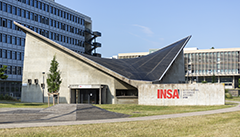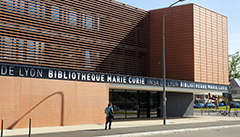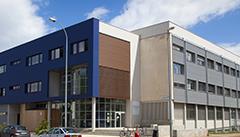
Sciences & Société
Soutenance de thèse : Abhilash VALISAMMAGARI
« Strain Evolution and Mechanical Failure in SiOx-Graphite Blend Electrodes for Li-Ion Batteries: An Experimental and Simulation Study »
Doctorant : Abhilash VALISAMMAGARI
Laboratoire INSA : MATEIS
École doctorale : ED34 : Matériaux de Lyon
Silicon is identified as a promising material for negative electrodes in next-generation lithium-ion batteries due to its high lithium storage capacity of 3579 mAh/g, which is nearly 10 times higher than the conventional graphite electrode capacity of 372 mAh/g. However, silicon's practical use faces critical challenges due to its volumetric expansion (up to 300%) during lithiation and delithiation cycles. This leads to mechanical degradation, such as electrode delamination and particle detachment, which diminishes performance and cycle life. To address these issues, researchers have turned to silicon oxides (SiOx), which offer a balance between high capacity and cycling stability by reducing volumetric expansion. Although SiOx has a lower capacity than pure silicon, it still outperforms graphite electrodes. However, the mechanical challenges like particle detachment are still existing, but, to a lesser extent than pure silicon. The objective of this thesis is to observe and understand the impact of particle swelling on the overall structural integrity of the electrode. Particularly, focussing on the loss of connectivity in the electrode and to extract possible information for optimizing SiOx-containing electrodes. For this puropose, experimental investigations, including synchrotron tomography and digital volume correlation, were used to gain high-resolution insights into both global and local strain field distribution within the electrode. Later, considering the granular structure of the electrodes, a particle-based method called Discrete Element Method (DEM) was employed to represent the microstructure of the electrode, and considering the insights from the experimental investigation such as the evolution of strains at the electrode scale, the coupling of particle swelling was performed to reproduce the global strain. Finally, the corresponding impact at the electrode scale swelling and the resulting detachement of the particles was assesed by conducting connectivity study on the assembly.
Informations complémentaires
-
Amphithéâtre 15 AIG/8, IFPEN (Solaize)

Sciences & Société
Soutenance de thèse : Valentine DELBRUEL
« Use of additive manufacturing for functional rehabilitation »
Doctorant : Valentine DELBRUEL
Laboratoire INSA : MATEIS
École doctorale : ED34 : Matériaux de Lyon
Since 2017, Humanity and Inclusion has used Fused Filament Fabrication (FFF) to produce prosthetics and orthotics in low-income countries. The initial outcomes were promising, but reliance on imported PP filaments from Europe led to logistical issues. This project aims to recycle plastic waste into 3D-printing filament for local orthopedic device manufacturing in Togo. First, a study evaluated PET, PP, and TPU materials based on availability, recyclability, printability, and mechanical properties. PP was selected for its semi-rigidity, ensuring patient comfort and support. Second, the printability and properties of PP-PE blends from recycling plants were studied. Thermal and rheological analyses highlighted the most promising composition for FFF: a PP matrix with 30 to 50% HDPE. Satisfactory mechanical properties were obtained due to in-situ compatibilization during processing. Ultimately, recycled blends with 70% PP – 30% HDPE, sourced from post-consumer waste from food packaging and post-industrial waste from orthopedic sheet production scraps, were transformed into filament and 3D-printed into AFOs through an optimization of the processing parameters. Third, durability assessments examined the accelerated aging resistance of PP under Togo weather conditions. Recycled PP was sensitive to thermo- and photo-oxidation due to impurities and degraded stabilizers. However, 3D-printing limited process-induced degradation, showing promise for aging resistance. Finally, mechanical tests on a walking bench compared 3D- printed AFOs from virgin and recycled materials with thermoformed PP AFO. While the thermoformed AFO showed the highest resistance, 3D-printed AFOs exhibited similar resistance, with virgin AFOs showing ductile rupture and recycled AFOs showing brittle rupture, highlighting the potential of recycled materials. To conclude, the perspectives for humanitarian applications are discussed, emphasizing the potential of emerging techniques such as Fused Granular Fabrication, which could simplify the manufacturing process and reduce costs.
Informations complémentaires
-
Amphithéâtre Gaston Berger, INSA-Lyon (Villeurbanne)

Sciences & Société
Soutenance de thèse : Aurore GOIGOUX
Experimental and theoretical analyses of the Rolling Contact Fatigue for indented surfaces
Doctorante : Aurore GOIGOUX
Laboratoire INSA : LAMCOS
École doctorale : ED162 : MEGA de Lyon (Mécanique, Energétique, Génie civil, Acoustique)
L’électrification des véhicules induit une modification des conditions opératoires des roulements présents dans les réducteurs. Cette application est caractérisée par une lubrification polluée.
Afin de développer des nouveaux matériaux efficacement, il est nécessaire de comprendre le mécanisme d’endommagement et d’en déduire les paramètres influents, ceci dans des conditions opératoires représentatives. Dans cet objectif, cette étude expérimentale et théorique est menée sur des roulements en 100Cr6 martensitique indentés par des particules dures. Le mécanisme d’endommagement est étudié basé sur deux approches : une caractérisation quantitative des indents et de leur endommagement et une caractérisation multi-échelle de la microstructure. Il est montré que les opérations de finition génèrent une fine couche plastiquement affectée à la surface qui n’évolue plus, ni après indentation, ni après fatigue, excepté sous l’épaulement de l’indent. Ainsi, l’épaulement est clé dans l’initiation de l’endommagement. D’abord, il se déforme et/ou s’use progressivement au cours de l’essai, son aspect de surface change et la zone rodée augmente. L’épaulement amont a un aspect de surface différent de celui aval, ce qui pourrait indiquer une déformation plastique plus avancée, expliquant la position préférentielle de la fissuration. Cette déformation engendre une plasticité avancée sous l’épaulement. Avec l’accumulation des cycles, une fissure s’y initie, certainement sur un défaut, comme l’interface carbure primaire/matrice. La propagation de la fissure n’est pas immédiate et consiste en deux processus distincts caractérisés par deux faciès de rupture différents. La fissure se propage d’abord dans une zone à la microstructure très fine, suggérant une propagation lente. La fissure modifie additionnellement la microstructure au-dessus d’elle, certainement par déformation et cisaillement entre les lèvres. La probabilité de fissuration est corrélée au temps d’essai, à la pression et au volume du creux de l’indent, mais pas à sa pente. L’influence du volume du creux pourrait s’expliquer par un volume d’épaulement plus important.
Informations complémentaires
-
Amphithéâtre Emilie du Châtelet (Bibliothèque Marie Curie) - Villeurbanne

Sciences & Société
Soutenance de thèse : Matthieu LAURENDEAU
« Tomographic incompleteness maps and application to image reconstruction and stationary scanner design »
Doctorant : Matthieu LAURENDEAU
Laboratoire INSA : CREATIS
École doctorale : ED160 : EEA (Electronique, Electrotechnique, Automatique)
Computed tomography (CT) is one of the most commonly used modality for three-dimensional (3D) imaging in the medical and industrial fields. In the past few years, new X-ray sources have been developed based on carbon nanotube (CNT) cathodes. Their compact size enables the design of a new generation of multi-source CT scanners. In contrast to traditional systems with a single moving source, these scanners often adopt stationary architectures where multiple sources are static. It would benefit both industry with cheaper and motionless systems and medical applications with light-weight and mobile scanners which could be brought to emergency sites. However, this type of scanner uses a fewer number of measurements, known as projections, and may acquire data with a limited range of angles, leading to well-known image reconstruction challenges. This thesis focuses on the design of such stationary CT scanners. Three axes of study are investigated.
The first contribution is the development of an object-independent metric to assess the reconstruction capability of a given scanning geometry. Based on Tuy's condition, the metric evaluates local tomographic incompleteness and is visualized through 3D vector field maps. It is further extended to handle truncated projections, improving its applicability to real-world configurations. The metric enables ranking different geometries, predicting image quality reconstruction, and identifying the origin of geometric artifacts. It is applied to a variety of geometries, including existing scanners.
The second is a novel local regularization method to address limited-angle reconstruction challenges. The method employs a directional total variation (DTV) regularizer whose strength and directional weights are adaptively selected at each voxel. The weights are determined based on the previously introduced metric. Two approaches for directional weights are explored: ratio-based weighting relative to image axes and ellipse-based weighting. The reconstruction algorithm is evaluated in both 2D and 3D simulations, considering noiseless and noisy data, as well as real data.
The third is a tool for optimizing the geometry of CT scanners. Given a fixed number of sources and the surface area available for their positions, the tool optimizes the placement of sources based on the proposed metric. Several state-of-the-art optimization algorithms are implemented and tested on simple 2D and 3D scenarios.
Informations complémentaires
-
Amphithéâtre de la délégation du CNRS Rhône Auvergne (Villeurbanne)

Sciences & Société
Soutenance de thèse : Nicolas Fernando PONCETTI
« Noise annoyance in open-plan offices and occupant fatigue: a study on the influence of age-related hearing loss »
Doctorant : Nicolas Fernando PONCETTI
Laboratoire INSA : LVA
École doctorale : ED162 : Mécanique, Énergétique, Génie Civil, Acoustique
Open-plan offices are common in the tertiary sector, yet occupants often complain about noise, particularly from co-worker conversations. This issue can differently affect normal hearing people and those with presbycusis. This study examines the impact of mild hearing loss (early-stage presbycusis) on performance, fatigue, and perceived workload, with a focus on the effect of irrelevant speech. An analysis of the decrease in performance on a serial recall task as a function of the intelligibility level of irrelevent speech was conducted with young, normal-hearing subjects under two auditory conditions: with and without a hearing loss simulator, as well as with hearing-impaired elderly subjects. Participants were exposed to five noise conditions and silence. Subjective intelligibility was also measured. The results showed a minor, non-significant difference in decrease of performance between normal-hearing and hearing-impaired participants. The hearing loss simulator produced results comparable to those of the older group, validating its efficacy. A second experiment involving prolonged noise exposure was conducted to examine factors such as fatigue and workload, which are challenging to evaluate in shorter experiments like the first one. In this experiment, a working day was simulated in an open-plan office, where participants performed clerical tasks while exposed to irrelevant speech. The results indicate that the intelligibility of the noise does not appear to significantly impact perceived fatigue and workload. Again, no notable differences were observed between the two groups studied.
Informations complémentaires
-
Amphithéatre Chappe - Bâtiment Hedy Lamarr - Villeurbanne

Sciences & Société
Soutenance de thèse : Chander BHAN CHANDER BHAN
« Photonics-based environmental sensors for automotive air quality monitoring »
Doctorante : Chander BHAN CHANDER BHAN
Laboratoire INSA : INL
École doctorale : EDA160 : EEA (Électronique, Électrotechnique, Automatique)
La pollution de l'air demeure un défi de santé publique, entraînant des problèmes de santé graves tels que des infections respiratoires aiguës, le cancer du poumon, etc.. Cela est principalement dû à l'inhalation d'air contenant de fortes concentrations de polluants, en particulier les hydrocarbures polyaromatiques comme le fluoranthène et le benzène, qui sont des polluants PM2.5 (particules d'une taille <= 2,5 µm) courants émis par les véhicules, les industries, etc. Les solutions actuelles sur le marché pour mesurer ces polluants, telles que les compteurs de particules optiques et les dispositifs MEMS basés sur les principes de diffusion de la lumière, sont souvent peu fiables, offrant une sensibilité réduite pour les particules fines (tailles < 0,1 µm). Par conséquent, il est nécessaire d'explorer des approches alternatives, telles que la manipulation de fluides sur puce par la lumière à l'aide de dispositifs photoniques intégrés, qui offrent une détection de taille de particule plus précise.
Cette thèse présente une solution utilisant des dispositifs de circuits photoniques intégrés sur une plateforme en SixNy pour la détection de l'indice de qualité de l'air. Pour surmonter les défis associés au piégeage de particules diélectriques de moins de 100 nm, la recherche explore diverses structures photoniques, notamment des guides d’onde diélectriques standards, des résonateurs en anneau à modes d'ordre supérieur (HOM) et des guides d'ondes plasmoniques hybrides. L'étude se concentre sur quatre composants clés de la photonique intégrée : les guides d'ondes en ruban diélectriques, les résonateurs en anneau HOM, les couplages par effilement inversé, et les résonateurs en anneau plasmoniques hybrides. Cette étude comprend leur conception, leur fabrication et leur compatibilité avec des plateformes industrielles telles que DAPHNE de STMicroelectronics. L'analyse des forces optiques, réalisée à l'aide de méthodes telles que le tenseur de contrainte de Maxwell et l'approximation de dipôle discret, fournit un cadre rigoureux pour optimiser la conception et évaluer différentes structures.
Informations complémentaires
-
Salle des thèses, Irène Joliot-Curie, INL Lyon (Villeurbanne)

Sciences & Société
Soutenance de thèse : Adrien DIDIER
« Mobiliser le chargement ultrasonique pour caractériser la fatigue de contact roulant : une étude de l'amorçage »
Doctorant : Adrien DIDIER
Laboratoire INSA : LAMCOS
École doctorale : ED162 : MEGA de Lyon (Mécanique, Energétique, Génie civil, Acoustique)
Les phénomènes d'endommagements causés par la fatigue de contact roulant sur une surface indentée sont reconnus comme responsables de la majorité des dysfonctionnements de roulements aéronautiques. Ces mécanismes d'endommagements sont encore mal compris en raison d'un manque crucial de données expérimentales. En effet, ces phénomènes ne se manifestent qu'après de nombreuses années, voire plusieurs décennies de fonctionnement, ce qui rend toute analyse expérimentale conventionnelle particulièrement laborieuse et chronophage. De plus, la simulation numérique de ce type d'endommagements est actuellement impossible, tant en raison du manque de données expérimentales disponibles que du nombre extrêmement élevé de cycles à simuler.
Afin de rendre accessible l'étude des sollicitations gigacyclique, nous avons conçu un dispositif de fatigue ultrasonique capable de reproduire un trajet de chargement analogue à celui d'un roulement sur une surface indentée, avec un chargement localement multiaxial et non proportionnel. Ce parallèle entre les deux trajets de chargement a été établi grâce à des simulations numériques par éléments finis. Ainsi, le dispositif expérimental permet de simuler l'équivalent de plusieurs décennies d'utilisation, soit plusieurs milliards de cycles, en seulement quelques dizaines d'heures. Cette étude a ainsi permis d'établir de nombreux liens entre la fatigue de contact roulant et la fatigue ultrasonique.
Elle a notamment permis d'expliquer le phénomène de transition des sites d'amorçage de fissures, qui se déplacent de la surface vers la profondeur du matériau, dans le cadre de la fatigue à très grand nombre de cycles. De plus, une analyse approfondie du raffinement local de la microstructure a été réalisée, mettant en évidence un lien direct avec l'amorçage en fatigue gigacyclique. Ce phénomène de raffinement a pu être expliqué et attribué à la même cause sous-jacente dans le cas de la fatigue des roulements et de la fatigue ultrasonique : le glissement dévié des dislocations (cross- slip).
Informations complémentaires
-
Amphithéâtre Seguin, INSA-Lyon (Villeurbanne)

Sciences & Société
Soutenance de thèse : Fadi KARKAFI
« Nonstationary vibration diagnostics of rotating machinery: application to aeronautic power transmission systems »
Doctorant : Fadi KARKAFI
Laboratoire INSA : LVA
École doctorale : ED162 : MEGA de Lyon (Mécanique, Énergétique, Génie civil, Acoustique)
Le bon fonctionnement des machines tournantes repose sur la surveillance vibratoire de composants rotatifs fragiles tels que les engrenages et les roulements. Concernant plus particulièrement le cas des systèmes de transmission de puissance en aéronautique, la surveillance vibratoire présente des défis considérables qui sont abordés dans cette thèse
: (i) les régimes de fonctionnement non stationnaires, qui nécessitent l'adoption d'approches synchrones, (ii) les interactions complexes entre différents sous-systèmes, susceptibles de masquer ou perturber les signaux de diagnostic et (iii) le bruit émis par diverses sources, tant environnementales qu’internes, rendant la détection des défauts plus difficile. Pour répondre à ces défis, les principes de diagnostic proposé dans cette thèse s'articulent autour de plusieurs objectifs : (1) une estimation fiable de la vitesse angulaire instantanée, permettant la synchronisation des signaux avec les variations du régime, (2) l'extraction des composantes vibratoires pertinentes pour isoler les composants mécaniques critiques et (3) l'application de diagnostics spécifiques à chaque composant, tenant compte des variations opérationnelles pour garantir robustesse et fiabilité. Les méthodologies développées sont validées par des données expérimentales, démontrant leur potentiel pour améliorer la fiabilité et la sécurité des systèmes de transmission en aéronautique.
Informations complémentaires
-
Amphithéâtre Emilie du Châtelet (Bibliothèque Marie Curie) - Villeurbanne

Sciences & Société
Soutenance de thèse : Gwendoline HOCHET DERÉVIANCKINE
« Feasibility and performance of a LoRa 2.4 GHz network »
Doctorante : Gwendoline HOCHET DERÉVIANCKINE
Laboratoire INSA : CITI
École doctorale : ED512 : Informatique et Mathématiques de Lyon
Long-range (LoRa) technology and the LoRaWAN protocol, which mainly uses the sub- GHz frequency bands, subject to regional laws, have become more widely used as a result of the rise of the Internet of Things (IoT). To overcome these limitations, Semtech has released a version of LoRa dedicated to the 2.4 GHz industrial, scientific, and medical (ISM) band, which, among others, is common worldwide and has no duty-cycle limitations. However, this frequency band is already used by many wireless technologies, such as Wi-Fi and Bluetooth (BT), as well as by common devices like microwaves and surveillance cameras. It is essential to evaluate the feasibility and possible performance of this frequency shift before deploying LoRa on a large scale in the 2.4 GHz ISM band.
This thesis proposes a comprehensive experimental evaluation of LoRa technology in the
2.4 GHz ISM band, including a comparison of its communication range and reliability with the European sub-GHz band (868 MHz). We also study the coexistence of LoRa and Wi-Fi when they are overlapping transmissions. To improve the coexistence, we propose and compare several frequency hopping (FH) strategies for LoRa. Although the latter proposal is based on simulation, we also propose an original methodology for evaluating a frequency band and selecting the less noisy channels, which could facilitate the implementation of FH strategies in future LoRa 2.4 GHz gateways. Our work provides important recommendations for the deployment and expansion of LoRa in the 2.4 GHz ISM band.
Informations complémentaires
-
Amphithéâtre Claude Chappe, Bâtiment Heddy Lamarr, INSA-Lyon (Villeurbanne)

Sciences & Société
Soutenance de thèse : Kayacan KESTEL
« Development of signal processing techniques for vibration-based condition monitoring of industrial rotating machines »
Doctorant : Kayacan KESTEL
Laboratoire INSA : LVA
École doctorale : ED162 : MEGA de Lyon (Mécanique, Energétique, Génie civil, Acoustique)
This dissertation introduces novel signal processing techniques and enhances existing ones for vibration-based condition monitoring of complex industrial rotating machines. The vibration-based condition monitoring field literature provides many solutions to reveal faulty patterns from a vibration signal. However, their performance on the vibration signals of modern complex machines has not been tested or is generally limited. Furthermore, they may often lack a robust version ready to be applied to real measurements. This study addresses these limitations with several proposals. Key research areas include the development of a stable blind filtering method to optimize Finite Impulse Response (FIR) filters for efficient fault detection and testing the proposed method on vibration signals obtained from a wind turbine gearbox. Additionally, the thesis advances the use of Generalized Likelihood Ratio test (GLRT)-based indicators for more stable and effective monitoring and proposes new statistical indicators with defined thresholds for improved reliability. Furthermore, it explores the impact of operational and environmental conditions on the vibratory behavior of wind turbine drivetrains, aiming to enhance the understanding and assessment of gearbox health through dynamic behavior analysis under varying conditions. These contributions offer substantial advancements in the practical application of signal processing in condition monitoring.
Informations complémentaires
-
Amphithéâtre Ouest, Bâtiment des Humanités, INSA-Lyon (Villeurbanne)

